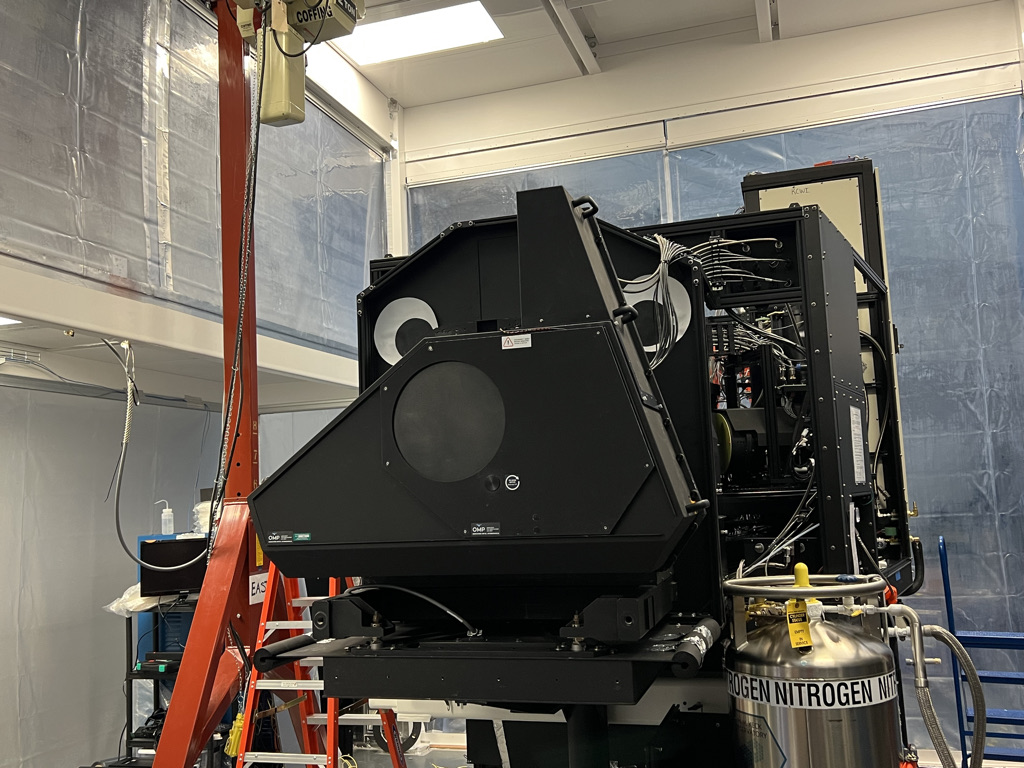Maunakea, Hawaiʻi – W. M. Keck Observatory is pleased to announce its newest instrument, the Keck Cosmic Reionization Mapper (KCRM), has successfully achieved “first light,” marking its first time ‘seeing’ the universe from Maunakea on Hawaiʻi Island. On Sunday, June 4, KCRM team members from Keck Observatory and Caltech captured a first-light image of the Turtle Nebula, or NGC 6210, located about 6,600 light-years away in the Hercules constellation.
“Because of the pristine view from Maunakea and KCRM’s remarkable depth of vision into the early universe, we have a new way for our galactic ancestors to reveal profound knowledge about our cosmic lineage and heritage,” says Rich Matsuda, interim director of Keck Observatory.
KCRM is designed to investigate the mysteries surrounding the era after the Big Bang when the cosmos was a toddler and light from the first stars transitioned the universe from darkness to light. This period of time is called the Epoch of Reionization (hence, KCRM’s name), when the first stars and galaxies began to form, emitting radiation powerful enough to burn through the dark, dense fog of cool hydrogen gas that filled the universe.
“Our understanding of the formation of the first galaxies and how they quickly evolved is incomplete,” says John OʻMeara, chief scientist at Keck Observatory. “With KCRM, we’ll be able to take direct measurements of the first galaxies that are at the edge of emergence from the Epoch of Reionization, just as they’ve started to mature after being born in the early chapters of the universe’s history.”

KCRM is a major upgrade to the Keck Cosmic Web Imager (KCWI), which was commissioned in 2017; together, they can take images in wavelengths of light that our eyes can see, with KCWI covering the blue side of the visible spectrum (wavelengths ranging from 350 to 560 nanometers) and KCRM covering the red side (wavelengths ranging from 560 to 1080 nanometers). Having both a blue arm and a red arm gives the combined instrument highly-advanced viewing power to not only travel back in time some 10 to 12 billion years ago and observe objects during the Epoch of Reionization, but also capture images of the vast strands of gas that stretch out across the universe connecting galaxies, called the cosmic web.
“I envisioned this instrument as a two-armed imaging spectrograph back in 2007, based on our Palomar Cosmic Web Imager but it was a long road to get the funding so we split the instrument into two halves,” says Christopher Martin, the instrument’s principal investigator and a professor of physics at Caltech. “KCWI was already doing phenomenal science with one arm tied behind its back, so now it’s off to the races! It is fitting that our first-light image shows two ‘arms’ of the Turtle Nebula! We would not have made it without the work of our fantastic instrument team, and support from Caltech, the Keck Observatory, the National Science Foundation, and a generous anonymous donor.”
The first-light image of NGC 6210 is a testament to the power of KCRM and KCWI; Martin says they captured the turtle-shaped nebula within about 5 minutes of observation and with such detail, the stubby ‘arms’ can be seen protruding from its ‘shell.’

In addition to studying the first galaxies and the cosmic web, both instruments can also observe gas jets around young stars, winds of dead stars, supermassive black holes, dark matter, and more.
“I’m excited to finally study galaxies in enough detail to understand why gas flows out,” says Rosalie McGurk, staff astronomer and KCRM lead at Keck Observatory. “KCRM will take my studies of merging galaxies, their supermassive black holes, and their outflowing gas to new heights. Studying them in multiple wavelength ranges simultaneously will help us determine whether energy from active black holes or star formation is pushing the gas out of the galaxies.”
With its KCRM upgrade now complete thanks to engineering teams from Caltech, UCO/Lick Observatory, and Keck Observatory, KCWI will be available again for science use starting in August.

ABOUT KCWI
The Keck Cosmic Web Imager (KCWI) is designed to provide visible band, integral field spectroscopy with moderate to high spectral resolution formats and excellent sky-subtraction. The astronomical seeing and large aperture of the telescope enables studies of the connection between galaxies and the gas in their dark matter halos, stellar relics, star clusters, and lensed galaxies. KCWI covers the blue side of the visible spectrum; the instrument also features the Keck Cosmic Reionization Mapper (KCRM), extending KCWI’s coverage to the red side of the visible spectrum. The combination of KCWI-blue and KCRM provides simultaneous high-efficiency spectral coverage across the entire visible spectrum. Support for KCWI-blue was provided by the National Science Foundation, Heising-Simons Foundation, and Mt. Cuba Astronomical Foundation. Support for KCRM was provided by the National Science Foundation and Mt. Cuba Astronomical Foundation.
ABOUT W. M. KECK OBSERVATORY
The W. M. Keck Observatory telescopes are among the most scientifically productive on Earth. The two 10-meter optical/infrared telescopes atop Maunakea on the Island of Hawaii feature a suite of advanced instruments including imagers, multi-object spectrographs, high-resolution spectrographs, integral-field spectrometers, and world-leading laser guide star adaptive optics systems. Some of the data presented herein were obtained at Keck Observatory, which is a private 501(c) 3 non-profit organization operated as a scientific partnership among the California Institute of Technology, the University of California, and the National Aeronautics and Space Administration. The Observatory was made possible by the generous financial support of the W. M. Keck Foundation. The authors wish to recognize and acknowledge the very significant cultural role and reverence that the summit of Maunakea has always had within the Native Hawaiian community. We are most fortunate to have the opportunity to conduct observations from this mountain.


